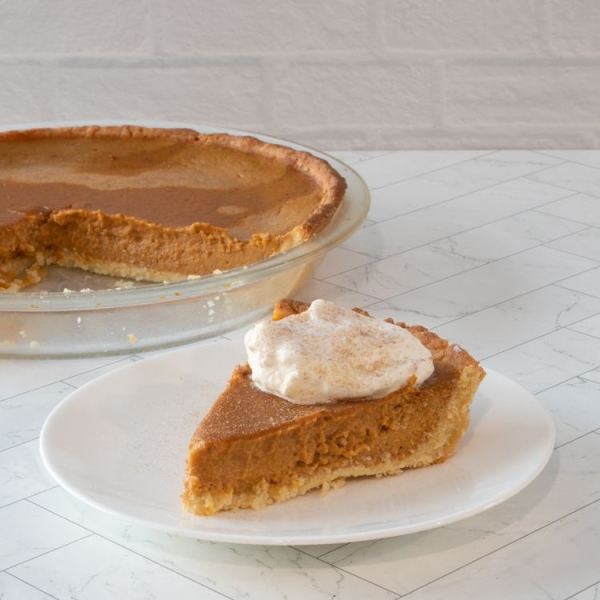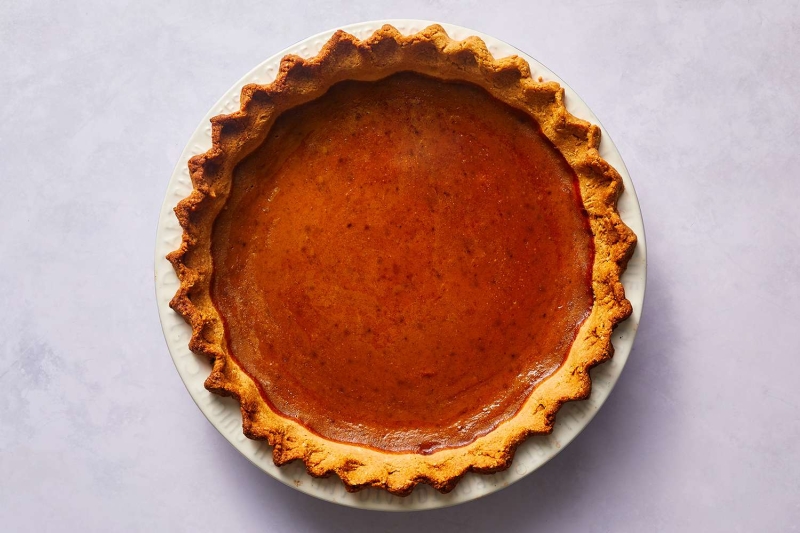Prep: 20 mins
Cook: 55 mins
Chill: 3 hrs
Total: 4 hrs 15 mins
Servings: 8 to 10 servings
Yield: 1 (9-inch) pie
Full of autumnal flavor, pumpkin pie is simply a spiced pumpkin custard baked in a flaky pie shell usually topped with a dollop of whipped cream.
The standard version of pumpkin pie is far from keto-friendly, so we came up with a version that is sugar-free, gluten- and grain-free, and low-carb. For the filling, we swapped the usual sweeteners for brown Swerve, which will most closely mimic the taste you expect from the classic recipe. We exchanged evaporated milk for heavy cream, resulting in a decadently rich filling.
For the keto pie crust, we used almond and coconut flours combined with xanthan gum, eggs, and powdered keto sweetener. Specifically, xanthan gum provides the structure for the crust in the absence of gluten. You’ll treat the crust just as you would a wheat one, making it in a food processor and then chilling and rolling it out. It may take a little more time than a standard crust, but it’s fairly forgiving and can be easily mended if it tears.
This sugar-free and low-carb version of pumpkin pie can be made days ahead of your holiday meal. Keep it in the fridge, then let warm slightly on the counter before serving. Top with whipped cream sweetened with a powdered keto sweetener and enjoy.
“The pie filling had all the great flavor you would find in a non-keto pumpkin pie. The custard was tasty and perfectly spiced. The crust worked well, too, but avoid an elaborate edge because it will over-brown in the time it takes to fully bake the filling.” —Diana Rattray

A Note From Our Recipe Tester
Ingredients
For the Crust:
-
6 tablespoons cold unsalted butter, cut into pieces
-
1 1/2 cups almond flour
-
4 tablespoons coconut flour
-
1/2 teaspoon kosher salt
-
1 teaspoon xanthan gum
-
2 tablespoons confectioners Swerve (or other erythritol-based sweeteners)
-
1 large egg
For the Filling:
-
1 (15-ounce) can pumpkin puree
-
3/4 cup brown Swerve (or other erythritol-based sweetener)
-
3/4 cup heavy cream
-
3 large eggs
-
2 teaspoons pumpkin pie spice
-
1 teaspoon vanilla extract
-
1/4 teaspoon kosher salt
Steps to Make It
Prepare the Crust
-
Gather the ingredients.

-
Add the butter, almond flour, coconut flour, salt, xanthan gum, and confectioners' Swerve to the bowl of a food processor. Pulse until the butter is dispersed into the flour and is in pea-sized pieces.

-
Add the egg and continue blending until the dough comes together into a ball.

-
Remove the dough from the processor and place onto a piece of plastic wrap. Fold the plastic wrap over the dough and pat into a disc. Refrigerate for one hour.

-
Remove the dough from the fridge and, keeping the plastic wrap over the surface of the dough, roll it out until it is 1 inch larger all around the 9-inch pie plate.

-
Transfer the dough to the pie plate. Crimp the edges of the dough as desired. Set aside while you prepare the filling.

Prepare the Filling
-
Gather the ingredients. Pre heat oven to 325 F.

-
Whisk the pumpkin puree, brown Swerve, heavy cream, eggs, pumpkin pie spice, vanilla, and salt together in a medium bowl.

-
Pour the filling into the prepared pie crust.

-
Bake on the upper oven rack until the pie is golden brown and just set, about 55 minutes (it may jiggle slightly in the center). Turn off the oven. Open the door to the oven about a quarter of the way. Allow the pie to cool completely in the oven. This will help prevent cracking. Once the pie is cooled to room temperature, cover it in plastic wrap and place it in the refrigerator. Chill for at least 2 hours.

-
Serve the keto pumpkin pie at room temperature or chilled. Top with keto-friendly whipped cream, if desired. Enjoy!

Tips
- Though you can use any keto sweetener in this recipe, we recommend brown Swerve because it provides the closest flavor and texture to the traditional dish. We do not recommend erythritol that doesn’t have prebiotics added, as it may turn crunchy when baked. If you cannot find brown Swerve, powdered monk fruit or allulose are the next best choices.
- If you’d prefer to use pumpkin pie filling over puree, omit the pumpkin pie spice.
- You can easily make your own pumpkin pie spice blend as well.
Keto Pie Crust Tips
- To roll, make sure you cover your counter with plastic wrap or parchment and place plastic wrap or parchment on top of the chilled dough to keep it from sticking to the rolling pin.
- If the dough cracks a bit or doesn’t stay in one piece when you invert it into the pan, it is easy to patch any bare or thin spots.
- The xanthan gum is required for the crust to be pliable enough to roll out. If you don’t have it on hand, try this without a crust or with a keto cookie crust.
- You need to chill the crust in order to help develop the structure of the dough. It can be chilled for up to several days in advance.
- When working with the crust, be careful to not overhandle as it is sticky.
- Once the crust is in the pan, use your fingers to crimp the edges and fix any tears. Work quickly so your hands don’t soften the butter.
- If the crust starts to get too dark in the oven, place a pie shield on the pie or pieces of aluminum foil on the edges to prevent further browning.
How to Store and Freeze
- Leftover pumpkin pie should be stored tightly covered in the fridge for up to three days.
- You can also freeze leftover pumpkin pie. Tightly wrap the entire, cooled pie or individual slices in plastic wrap followed by aluminum foil and store for up to a month. Defrost in the fridge before enjoying.
Is pumpkin okay on keto?
A half cup of pumpkin contains about 10 grams of carbs. Because there are fewer than 2 cups of pumpkin in the entire pie, the pumpkin accounts for only 4 to 5 grams of carbs per serving.
| Nutrition Facts | |
|---|---|
| Servings: 8 to 10 | |
| Amount per serving | |
| Calories | 284 |
| % Daily Value* | |
| Total Fat 24g | 31% |
| Saturated Fat 10g | 51% |
| Cholesterol 113mg | 38% |
| Sodium 266mg | 12% |
| Total Carbohydrate 12g | 4% |
| Dietary Fiber 5g | 16% |
| Total Sugars 4g | |
| Protein 8g | |
| Vitamin C 2mg | 10% |
| Calcium 115mg | 9% |
| Iron 2mg | 10% |
| Potassium 282mg | 6% |
| *The % Daily Value (DV) tells you how much a nutrient in a food serving contributes to a daily diet. 2,000 calories a day is used for general nutrition advice. | |


